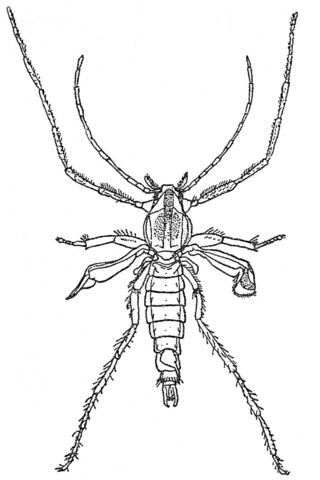
The Chironomidae comprise a family of nematoceran flies with a global distribution. They are closely related to the Ceratopogonidae, Simuliidae, and Thaumaleidae. Many species superficially resemble mosquitoes, but they lack the wing scales and elongated mouthparts of the Culicidae.
Antillocladius is a genus of midges belonging to the family Chironomidae, subfamily Orthocladiinae. The name Antillocladius means orthoclad that occurs in the Antilles, where it was primarily recorded.

The genus Axarus is widely distributed with records from the Holarctic, the Neotropics and Australasia . There are currently 5 described nearctic species . Erected as a subgenus (Anceus) of Xenochironomus , Axarus was subsequently renamed and elevated to generic status . The Connecticut River in the eastern United States harbors locally dense populations of two Axarus species, both currently undescribed. These populations are interesting in that they are restricted to specific larval habitat and thus there is genetic structure between populations in the river . The Connecticut River species are also notable in that they have extremely well developed polytene chromosomes and also maintain a high degree of inversion polymorphism .
Asheum is a genus of European non-biting midges in the subfamily Chironominae of the bloodworm family Chironomidae. It was originally named Pedionomus by James E. Sublette in 1964; this name was discovered by Patrick Ashe to be preoccupied by PedionomusGould, 1840, so it was renamed to Asheum by both James E. and Mary S. Sublette in 1983, naming it after Patrick Ashe. Asheum is sometimes considered to be a subgenus of Polypedilum.
Apometriocnemus is a genus of non-biting midges in the subfamily Chironominae of the bloodworm family Chironomidae.
Gymnometriocnemus is a genus of non-biting midges in the subfamily Orthocladiinae of the bloodworm family (Chironomidae). The genus is divided into two subgenera, Raphidocladius Sæther 1983 and Gymnometriocnemus Goetghebuer, 1932. Males of the former subgenus are characterized by possessing an extremely long virga with needle-like sclerotization, species of the later characterized by a short virga and a weakly developed crista dorsalis in the adult male hypopygium.

Tanytarsus is a large genus of non-biting midges of the tribe Tanytarsini and subfamily Chironominae of the bloodworm family (Chironomidae). The larvae of these insects occur in a wide range of freshwater habitats with some species being marine.

Chironominae is a subfamily of midges in the non-biting midge family (Chironomidae).

Chironomini is a tribe of midges in the non-biting midge family (Chironomidae).

Polypedilum is a genus of non-biting midges in the subfamily Chironominae of the bloodworm family Chironomidae. This is probably the most species-rich of all chironomid genera. Larvae of Polypedilum may also be among the most abundant invertebrates in eutrophic ponds, reaching densities of up to 1200 larvae per square meter.
Einfeldia is a genus of non-biting midges in the subfamily Chironominae of the bloodworm family Chironomidae.

Glyptotendipes is a genus of non-biting midges in the subfamily Chironominae of the bloodworm family Chironomidae.

Microtendipes is a genus of non-biting midges in the subfamily Chironominae of the bloodworm family Chironomidae.
Cryptochironomus is a genus of non-biting midges in the subfamily Chironominae of the bloodworm family Chironomidae.
Stictochironomus is a genus of non-biting midges in the subfamily Chironominae of the bloodworm family Chironomidae. Members of this genus often have strongly marked wings and legs. The larvae of these midges may also have distinct dark patterns on the dorsal side of the head capsule. They live in sand and other sediments in a variety of fresh water habitats in densities of several hundred per square meter.
Parachironomus is a genus of non-biting midges in the subfamily Chironominae of the bloodworm family Chironomidae.

Tanytarsini is a tribe of midges in the non-biting midge family (Chironomidae).

Diamesinae is a subfamily of midges in the non-biting midge family (Chironomidae).
Diamesini is a tribe of midges in the non-biting midge family (Chironomidae).

Pontomyia is a genus of flightless marine midges belonging to the subfamily Chironominae in the Chironomidae family. Insects in marine environments are extremely rare while flightlessness, extreme sexual dimorphism, and an extremely short adult life span contribute to making these midges unusual among insects. They are known from the shores of islands in the Indian, Atlantic and Pacific Oceans.








